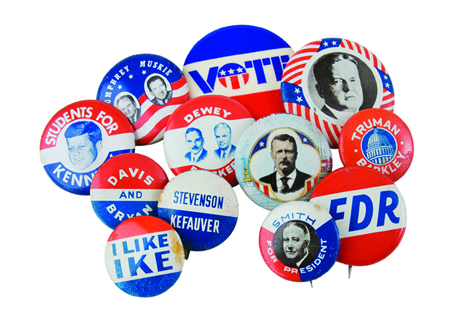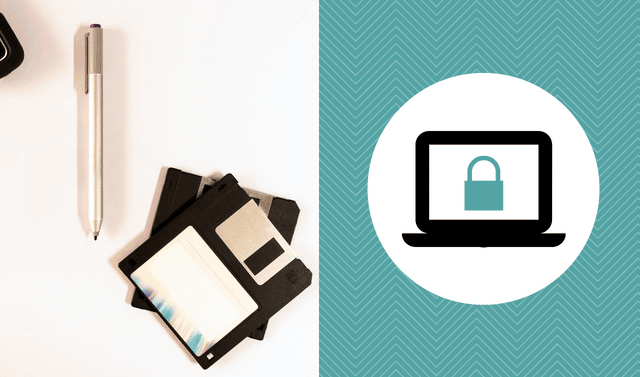Sign up for the Family Tree Newsletter Plus, you’ll receive our 10 Essential Genealogy Research Forms PDF as a special thank you!
Get Your Free Genealogy Forms
"*" indicates required fields

Inauguration Day happens every four years on Jan. 20 (or, if that’s a Sunday, Jan. 21) to begin the recently elected US president’s term of office with the Inaugural Oath, as directed by the Constitution.
If your ancestors endorsed a presidential candidate, your family archives might contain campaign memorabilia—typically a grab bag of different types of items. You might find t-shirts, toys, bumper stickers, buttons and more. Take time to sort and properly preserve the artifacts you want to save for posterity in the proper containers, following these ten tips:
1. Buffer the paper.
Keepsakes like campaign flyers, posters and event tickets are often mass-produced using inexpensive paper and adhesives. They start to deteriorate almost as soon as they’re made. To prolong the life of these items and help prevent their toxic acids from staining and damaging other things in your collection, store them individually in acid-free, buffered folders, envelopes or plastic sleeves. The buffering agents help neutralize the acids in paper. Archival storage materials are available in a range sizes from suppliers such as Gaylord.com (check out our list of archival suppliers for more).
2. Separate stickers.
Bumper stickers are often printed on paper or vinyl with an adhesive backing. The glue can cause the stickers to adhere to each other or to other materials, so it’s important to separate them and store them upright to minimize pressure. Place them in acid-free folders or use sheets of acid-free paper between stickers, and store them in an acid-free box or metal filing cabinet away from light and dust. The plastic material in vinyl bumper stickers can emit gasses harmful to photos and paper; be careful to store the stickers in a separate container.
3. Don’t wrap your artifacts in newspaper.
Newspaper ink can easily transfer to the object. Instead, use acid-free tissue paper and store in an archival cardboard box.
4. Let buttons breathe.
Metal campaign buttons will rust and corrode if you store them in a humid environment. They’re best preserved inside a breathable container, rather than inside a plastic bag or box where moisture can accumulate. Look for a shallow artifact box made of acid-free cardboard, or place buttons in individual compartments of a plastic parts box along with a few silica gel packets (also from an archival supplier) to absorb dampness. Separating the buttons also helps prevent scratching. Store the container away from any light that will fade printing.
5. Handle with care.
Campaign memorabilia was intended for temporary use. Plastic items, such as souvenir buttons, are made from highly unstable, cheap materials. Protect plastic buttons from chipping and staining by wearing clean gloves when handling them and wrapping them in acid-free tissue for storage. Avoid using commercial cleaners or solvents. As with other printed materials, store them away from light.
6. Protect plastics.
Don Williams, senior conservator at the Smithsonian Institution, notes that the “degradation of plastics is always under way, unstoppable and permanent.” He recommends three methods of storage for tissue-wrapped plastic items: on open shelving in a darkened area, inside acid-free boxes with fabric-covered ventilation holes, or inside a sealed container with oxygen and chemical absorbers such as Ageless oxygen scavenger or activated charcoal, available from archival suppliers.
7. Save signatures.
If your relative was fortunate enough to collect his candidate’s autograph, preserve the signature by storing it away from all light. Impromptu signatures are often made on scrap paper with any pen or pencil at hand, not usually created for longevity. To display the keepsake, Williams suggests placing the autograph in an acrylic display case that can be stored in the dark when not on view.
8. Keep newspapers in folders.
Newspaper publishers have printed millions of extra copies to announce election results. Like anything made with high-acid pulp paper, though, newspapers deteriorate quickly and easily stain adjacent items. Store souvenir papers flat and unfolded in an archival box made especially for newspapers. Separate individual issues by keeping them in large, acid-free folders. An inexpensive alternative is to purchase large sheets of acid-free board from a local art supply store and make your own archival folders. Store away from light, heat, pests and moisture.
9. Learn to like layers.
Protect any keepsake with layered storage. The first layer that encloses the item should be made from high-quality archival materials. This folder or sleeve can be placed inside an archival box. Finally, the box should be stored in a clean, dry, dark location with moderate temperature and humidity inside your home, such as an interior closet.
10. Create a collection.
Are you a political history junkie looking to expand your collection of American campaign memorabilia? Check out resources, price guides and collecting tips from the American Political Items Collectors organization and its affiliated Facebook groups. Warman’s Political Collectibles (Krause) is a colorful guide to collecting all kinds of political memorabilia, from coins and medals to toys, clocks and kitchenware.
A version of this article appeared in the January/February 2017 issue of Family Tree Magazine.
ADVERTISEMENT




